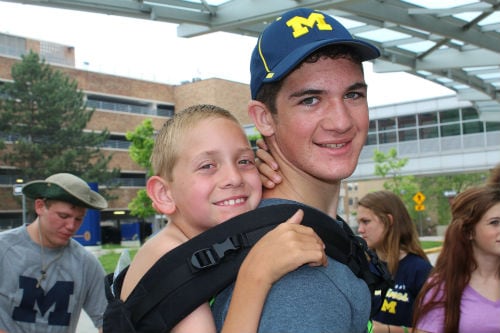Living with Cerebral Palsy: The Gandee Family Story
March 25th is Cerebral Palsy Awareness Day. Cerebral palsy (CP) is the most common motor disability of childhood, and children and families living with CP need support. Read about one family’s experience living with CP.
In 2015, Hunter Gandee was chosen by Sports Illustrated as the High School Athlete of the Year for his and his family’s efforts to increase awareness of cerebral palsy (CP), a condition that affects his younger brother Braden. Together, they launched a walk called Cerebral Palsy Swagger, in which Hunter walked over 40 miles with Braden on his back to highlight the challenges children like Braden face. Read more to hear from 9-year-old Braden, 16-year-old Hunter, and their mother Danielle about their experiences as a family living with CP.

Brothers Braden (left) and Hunter (right)
Braden’s Story
I wanted to do our walk because I knew there were other people out there like me, and maybe they needed help and didn’t have brothers and sisters like mine. I wanted to do it to help them.
My brother Hunter teaches me to work hard. My sister Kerragan treats me like normal: she does art with me, plays video games with me, fights with me, and gets annoyed at me. My brother Kellen is my best friend, and he helps me when my muscles don’t do what I want them to do. He reaches things for me, helps me clean up, and gets my walker unstuck. I support them by cheering for them as loud as I can at their sports.
People with CP are just like everyone else. Everyone has things that they are good at and things they have a hard time doing. Don’t let anything stop you. Don’t BE Cerebral Palsy. Be brave. Be strong. Be proud. Be you.
My advice for brothers and sisters of people with CP is just be their brother or sister. To everyone else, my advice is to ask people with CP if they want help when things are hard for them, but don’t think they can’t do things. They can, but it just might look different.
Hunter’s Story
“I hope for a day when our world is adapted to be inclusive for everyone with different abilities.”
– Hunter Gandee
Our walk was actually a dream that my mom had where I was carrying my brother to raise awareness for CP. We knew we wanted to help my brother and others with CP, so we took action.
Having a sibling with CP has greatly impacted my perspective on absolutely everything, especially my views on the importance of faith, hard work, and a more accessible society.
My advice for other people who have a sibling with CP is to always be there for them. Help them in any way you can to help them become successful. Also, just try to make them smile. Remember that sibling fun and play is just as important as therapy in helping them to lead a better life.
Danielle’s Story
After a difficult pregnancy, Braden was born at 32 weeks and not strong enough to breathe on his own. He was diagnosed with periventricular leukomalacia* (PVL) before he left the neonatal intensive care unit four weeks later. PVL, we were told, usually results in CP. Because we knew he had CP from the beginning, we were able to get Braden started on physical therapy by the age of 3 months, and that made a big difference.
Braden’s official diagnosis came at his one year checkup. I think that because we knew all along that he probably would have CP, it was not as hard to hear as it is for others. We have learned over time not to dwell on the past, don’t ask ‘why,’ or ‘what if.’ We also don’t set expectations for the future. Instead, we approach each day asking ‘What can we do today?’ Day by Day. Step by Step. We learn what Braden’s CP is together.
The biggest advantage is that we have been blessed with the chance to help others. Through the grace of God and the amazing support of our community, family, and friends, we have been able to start a movement to make the world more accessible and inclusive for people with different abilities. In my opinion, the biggest challenge is the limit on mobility equipment and the limits of society and environmental designs, so that is a big focus in our project.
*Periventricular leukomalacia is a type of brain injury that affects infants and is more common among premature infants.
CDC would like to thank Braden, Hunter, and Danielle for sharing their personal stories. We invite you to read other stories written by persons living with CP on CDC’s Cerebral Palsy Webpage.